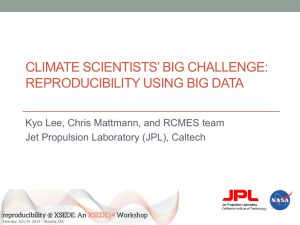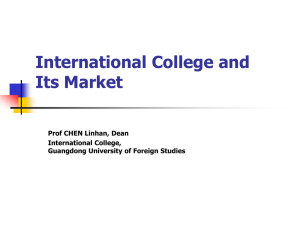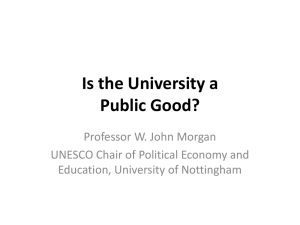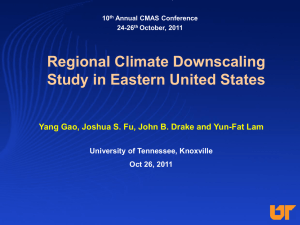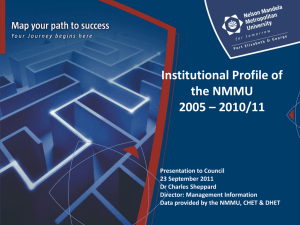Nelson Mandela Metropolitan University
advertisement
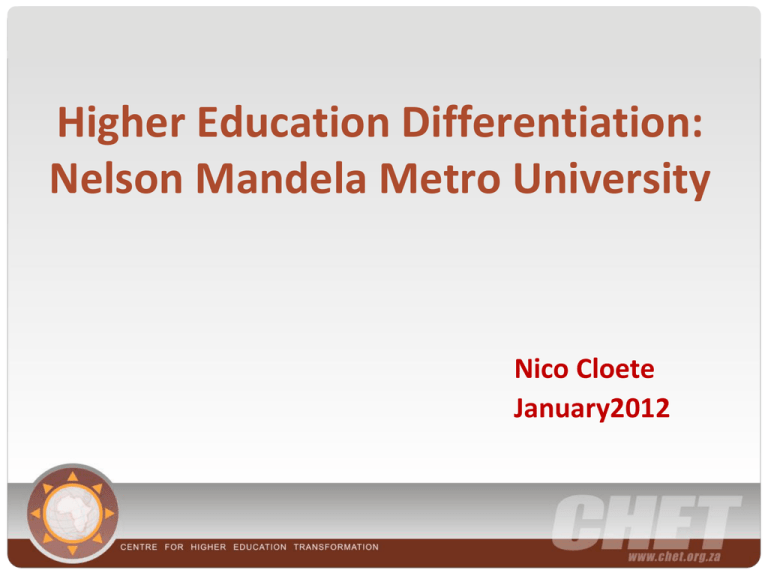
Higher Education Differentiation: Nelson Mandela Metro University Nico Cloete January2012 Complimentary but disconnected discourses 1. DHET a) Should have combined with DST b) Shocked by Charles finding of 3 million NEET’s and have become besotted with FET and training c) In Ministers budget speech referred to research on page 12 and never used knowledge economy and Africa, not to mention the globe (a local communist) 2. DST b) Opening line knowledge economy and global competitive c) Presses all the knowledge production buttons d) Never spoke to DHET advisor 2 Differentiation (NPC) (1) Functions of HE Higher education is the major driver of the information-knowledge system, linking it with economic development...Universities are key to developing a nation. They play three main functions in society. Firstly, they educate and train people with high-level skills for the employment needs of the public and private sectors. 3 Secondly, universities are the dominant producers of new knowledge, and they critique information and find new local and global applications for existing knowledge. Universities also set norms and standards, determine the curriculum, languages and knowledge, ethics and philosophy underpinning a nation's knowledge-capital. South Africa needs knowledge that equips people for a society in constant social change Differentiation (NPC) (2) Functions "Thirdly, given the country's apartheid history, higher education provides opportunities for social mobility and simultaneously strengthens equity, social justice and democracy. In today's knowledge society, higher education underpinned by a strong science and technology innovation system is increasingly important in opening up people's opportunities." (p262) For the first time knowledge production and equity are linked by stating that "high quality knowledge production cannot be fully realized with a low student participation rate" (p274). 4 Also universities are not mainly fro individual mobility or for equity redress - equity is mentioned last and transformation not once Differentiation (NPC) Knowledge The NPC is so enthusiastic about knowledge that it declares that "knowledge production is the rationale of higher education" (p271) - indeed a radical departure from the traditional 'rationale' of higher education in Africa, that is, disseminating (teaching) knowledge from somewhere else. Description of SA system: 1. 2. 3. 4. 5 Medium knowledge producing Insufficient skills producing Low participation and high attrition Differentiated. NPC Knowledge Policies 1. the notion of knowledge production consists of a combination of PhD education and research output. 2. a target of tripling the number of doctoral gradates from 1,420 to 5,000 per annum, and increasing the proportion of academic staff with PhDs from 34% to 75% 3. a number of world-class centres and programmes should be developed within the national system of innovation and the higher education sector. 4. a new future scholars programme needs to be developed, both to increase the proportion of staff with PhDs and to meet the increasing demand for professional PhDs in the non-university research, financial and services sectors 5. role of science councils should be reviewed in light of the worldwide tendency to align, or merge, research councils with universities 6 NPC Differentiation (1) "South Africa needs to strengthen research excellence through performance-based grants. More weight should be given to building departments, and centers or networks of excellence. Given that performance-based grants can entrench historical privilege and disadvantage, capacity-building grants should be provided with clear targets for improvement in five-year intervals. 7 "...progressive differentiation requires that all higher education institutions provide high quality education and skills training, underpinned by common standards for student facilities, libraries, laboratories, computer access and staff qualifications. Adequate resourcing will be needed to enable historically disadvantaged institutions to achieve these standards and overcome historical backlogs." (p291) NPC Differentiation (2) 1. deals with the worldwide policy debate about the concentration of resources by proposing world-class centers and programmes across institutions 2. advises the Ministerial Committee for the Review of the Funding of Universities that such revisions should be based on the needs of a differentiated system with adequate provision for both teaching and research 3. requires flexible pathways for student mobility between institutions 4. the Higher Education Quality Committee should finally start developing a core set of quality indicators for the whole system; 8 NPC Differentiation (3) 5. Should be guided by evidence-based planning and performance monitoring which will require maintaining and strengthening the current Higher Education Management Information System and the additional capacity to analyze national trends and changes between and among institutions and institutional groups. 9 DHET Green Paper (1) History/diagnosis 1. Diverse system steeped in inequality 2. Leading universities internationally respected, HBU’s mired in constraints 3. Univ of Technology, and Comprehensives mission drift losing focus of their mission to produce technologists mid level undergraduate skills 4. low success, low throughput at under-graduate 5. too few post graduate, particularly Phd 6. Aging academic staff and shortages in scarce skills areas 7. Lack of coherence and articulation 10 DHET Green Paper (2) Research and innovation 1. Economic depends on innovation and technology absorption 2. While investment in research has tripled, there has not been a commensurate increase in personnel 3. Total knowledge output has increased 64% (2000-2009) but the system must become more productive 4. Poverty is a significant constraint on masters and Phd studies – students under pressure to obtain jobs?? 5. Drastically increase number and quality of masters and PhD’s 6. Need for increased coordination between DHET and DST 7. Caliber and workload of academic staff must be addressed 8. Long term plan for renewing the academic profession doctorates for academics and professions 11 DHET Green Paper (3) : Differentiation 12 1. Differentiation must take cognizance of historical inequalities, existing institutional types, and a few relatively research intensive universities responsible for most of the post graduates and cutting edge research. Their needs must not divert resources from all the universities, particularly poorer ones - all must have sufficient resources to be effective institutions 2. Because of the high unit value per research output , funding framework is biased towards rewarding research at the expense of teaching– 3. High increase in research output by advantaged universities who have the means to “chase” research. The rigidity of the funding system discourage implementation of flexible curricula like 4 year undergraduates (p46) DHET Green Paper (4) : Differentiation 1. No further categorization of institutions 2. All institutions must have a clearly defined mandate 3. Undergraduate/post graduate and academic/professional/vocational equally important 4. Mix and level of programmes not fixed 5. All must offer high quality undergraduate programmes 6. University system must interface with PSE (Fet, colleges) 7. Funding regime must do justice to current institutional realities, and accept need for redress (development) 8. Funding for agreed upon outputs 13 Differentiation Principles 1. The most important principle is that the country needs the entire spectrum of institutions for socio-economic development 2. Mix and level of programmes of any institution should not be cast in stone institutions must identify and enhance their strengths 3. All universities in South Africa must offer a quality undergraduate education 4. Reward equally the different roles of higher education in South African society, namely teaching and learning, community involvement, as well as research 5. A national plan should be developed in tandem with differentiation – coordination and a human development plan 6. Manuel Castells argued at Chet book launch that each country needs at least one or two institutions that sets the national benchmark, not only for research but also for student and academic aspirations, and in the popular imagination; otherwise the entire system ‘wallows in similar mediocrity’ 14 Commonalities between NPC and DHET 1. No new types of institutions, no world class (Norwegian janus faced protestant hypocrisy) – DHET “all over the world there are universities with a predominant teaching mission” 2. Knowledge production (PhD and research output must increase – different counts of research outputs) 3. Big focus on doctorate – for academics (target more than 60%), professions research councils and other sectors (finance) 4. Good quality undergraduate education – including infrastructure funds for labs, libraries, housing 5. Improvement of through put – efficiency 6. Dramatic increase in participation rate – mainly in FET 7. Mission and profile differentiation 15 D: ACADEMIC PROGRAMMES 17 The slides which follow summarise the academic programme framework within which the SA higher education system is expected to operate. The summary is based on the current categories of (a) universities, (b) comprehensive universities, and (c) universities of technology. 18 Two preliminary points to note are: • key components of academic programmes are, for these purposes, students registered for qualifications within major fields of study • qualifications can be grouped either (a) by type: general formative or professional or career-focused, or (b) by level : undergraduate or postgraduate. 19 The analyses which follow will use both the qualification type and qualification level categories. 17 ACADEMIC PROGRAMMES (continued) 20 General formative qualifications: all degrees, diplomas and certificates awarded at all levels in these major fields of study: • CESM 03: visual & performing arts • CESM 12: languages & literature • CESM 15: life & physical sciences • CESM 16: mathematical sciences • CESM 18: philosophy & religion • CESM 20: psychology • CESM 22: social sciences 18 ACADEMIC PROGRAMMES (continued) 21 Professional qualifications: all 4-year or more bachelors degrees, postgraduate diplomas in case of education only, all honours, masters and doctoral degrees in these CESM categories: • CESM 01: agriculture • CESM 02: architecture, building science and planning • CESM 04: business and management • CESM 05: communications • CESM 06 computer science • CESM 07 education • CESM 08 engineering • • • 19 ;, ACADEMIC PROGRAMMES (continued) • CESM 09: health sciences & services • CESM 10: home economics • CESM 11: industrial arts • CESM 13: law • CESM 14: librarianship; • CESM 19: physical education • CESM 21: public administration & social services 22 Career-focused qualifications: all undergraduate certificates and diplomas, 3year bachelors degrees, and postgraduate diplomas( other than education) in the CESM categories listed in paragraph 5 above. 20 ACADEMIC PROGRAMMES (continued) 23 The institutions in the three categories are: Universities of technology: CPUT, CUT, DUT, TUT, VUT, MUT Comprehensive universities: UJ, NMMU, Unisa, Unizul, Univen, WSU Universities: UCT, Fort Hare, Free State, UKZN, Limpopo, NWU, Pretoria, Rhodes, Stellenbosch, UWC, Wits 24 The 8 case study institutions are: UCT, Fort Hare, UKZN, NWU, UWC, Wits, NMMU, TUT 21 ACADEMIC PROGRAMMES (continued) 25 Graph 15 summarises the HE system’s 2009 student enrolment within the three categories of institution and the qualification types defined earlier Graph 15 Student enrolments by qualification type: 2009 120% 100% 32% 80% 60% 72% 59% 40% 40% 25% 20% 0% 20% 8% Universities of technology General formative 28% 16% Comprehensives Professional Universities Career focused 22 ACADEMIC PROGRAMMES (continued) 26 Graph 16 summarises the 2009 student enrolments of the 6 universities of technology within the qualification types defined earlier. Graph 16 University of technology enrolments by qualification type: 2009 120% 100% 80% 60% 61% 63% 71% 74% 79% 96% 40% 20% 0% 23% 16% CUT 30% 7% 20% 9% 20% 6% 11% 10% 2% CPUT TUT DUT VUT MUT Ge ne ral form ative Profe s s ional Care e r focus e d 23 ACADEMIC PROGRAMMES (continued) 27 Graph 17 summarises the 2009 student enrolments of the 6 comprehensive universities within the qualification types defined earlier. Graph 17 Comprehensive university enrolments by qualification type: 2009 120% 100% 80% 60% 32% 36% 40% 20% 33% 45% 35% 60% 61% 61% 23% 23% 24% 47% 32% 23% 18% 17% 16% 15% Univen Unizul NMMU UJ WSU UNISA 0% General formative Professional Career focused 24 Programme Distribution: General Formative- Professional- Career 2008 - Traditional Universities 2008 - Comprehensive Universities 100% 100% 90% 80% 70% 60% 54% 46% 47% 34% 44% 47% 47% 46% 46% 69% 24% 49% 24% 47% 48% 44% RU US 39.3% 42.1% 29.1% 22.1% 38.6% 30% 8% 8% 13% 17% 5% 7% UCT WITS UFH UWC UL UKZN Career-Focused Professional 19% 24% UP 35.7% 21.5% 15.3% 43.7% 66.2% 52.0% 20% 35.2% 46.1% 51.7% UJ NMMU 10% 0% UFS 12.3% 26.1% 60% 40% 35% 48% 10% 0% 39% 37% 46% 7% 80% 50% 43% 40% 30% 90% 70% 50% 20% 28% NWU 6.0% UNIVEN UZ Career-Focused General Formative UNISA Professional WSU General Formative 2008 - Comprehensive Universities 100% 1.7% 9.9% 90% 18.4% 17.5% 81.6% 82.5% 25.5% 18.9% 74.5% 77.0% 80% 70% 60% 50% 98.3% 40% 30% 20% Trendline 1 10% Trendline 1 0% MUT VUT Career-Focused DUT Professional TUT CPUT General Formative CUT Source: Martin Oosthuizen, NWU 24 ACADEMIC PROGRAMMES (continued) 28 Graph 18 summarises the 2009 student enrolments of the 11 universities within the qualification types defined earlier. Graph 18 University enrolments by qualification type: 2009 120% 100% 20% 25% 22% 22% 25% 26% 27% 80% 60% 47% 32% 46% 48% 32% 29% 39% 33% 32% 43% 30% 48% 34% 51% 43% 39% 22% 40% 20% 35% 33% 33% 51% 37% 35% 28% 14% 19% 0% UCT SU UL Wits UWC Ge ne ral form ative UFH RU Profe s s ional UKZN UP UFS NWU Care e r focus e d 25 EXAMPLES OF CASE STUDY UNIVERSITIES: NMMU 34 Graph 25 shows that that NMMU’s academic offerings in terms of qualification types has remained stable over this period 2003-2009. Graph 25 NMMU student enrolments by qualification type 70% 60% 50% 40% 30% 20% 10% 0% 57% 53% 28% 28% 20% 15% 2003 2005 General form ative 59% 56% 24% 17% 26% 18% 2007 Professional 2009 Career focused 32 NMMU EXAMPLE (continued) 35 The graph below also presents a picture of stable programme offerings, with NMMU remaining a predominantly undergraduate university. Graph 26 NMMU student enrolments by qualification level 100% 80% 60% 40% 20% 0% 2003 2005 2007 2009 86% 88% 89% 86% P/grad<Masters 7% 5% 4% 6% Masters + doctors 7% 7% 7% 8% U/grad 33 Staff Differentiation – General formative programmes The purpose of general formative programmes is to give students a firm foundation in basic disciplinary knowledge. Relevance should therefore be assessed in the following ways: • The programme is responsive to the demands of the knowledge field • The curriculum provides students with a sound induction into the conceptual foundations of the disciplines studied • Teaching staff are aware of advances in knowledge, as reflected in the latest research and trends in the development of their disciplines, and incorporate these into the curriculum where appropriate • Students engage with core notions of citizenship, democracy and ethics, especially in relation to their disciplinary studies • Students are given an introduction to research methodology • A significant proportion of the staff is research active with national and international links to peers in their disciplines 28 STAFF – Professional programmes The purpose of professional programmes is to give students a sound knowledge base and set of skills and competencies to enter into a field of professional practice. Relevance should therefore be assessed in the following ways: 29 • The programme is responsive to the demands of the field of professional practice • The curriculum has an appropriate balance of the disciplinary knowledge on which the field is grounded, and field (profession) specific knowledge • Students acquire the skills and competencies to enable them to perform optimally in their field of practice • Where appropriate, students are given the opportunity to acquire workplace experience (e.g. clinical practice, teaching practice, practice in law clinics, etc.) • Students engage with core notions of citizenship, democracy and ethics, especially as they relate to professional practice • Teaching staff are aware of the latest developments (including research, new legislation, and professional regulations) relating to their field of practice and incorporate these into the curriculum where appropriate • Teaching staff maintain strong links with regulatory bodies such as professional boards and councils • A significant proportion of the teaching staff has professional accreditation STAFF: Career and occupation-specific programmes The purpose of career and occupation-specific programmes is to prepare students for specified occupational and career niches in the labour market. For this, students need to be sufficiently practically and procedurally competent to be considered work ready. Relevance should therefore be assessed in the following ways: 30 • The programme is highly responsive to the demands of the workplace • The curriculum is context-driven • There is an appropriate balance of principled and procedural knowledge, and of generic and specific skills • There is sufficient conceptual knowledge to allow students to continue learning after graduation in the context of changes in the workplace • Students engage with core notions of citizenship, democracy and ethics, especially as they relate to the workplace • Teaching staff are aware of changes and developments in the industrial / business environment and keep the curriculum up to date in relation to these developments • Teaching staff maintain strong links with industry • A significant proportion of the teaching staff has industry experience Challenges 1. Scale up Knowledge production - PhD’s and research outputs – Chet study 2. Efficiency improvements – the submerged discourse – shift to output funding 3. Participation rate - pressure for admission due ‘easier matric’, but mainly what is your role in FET sector 4. World class networks/institutes – Korea (Brain 21) – individual vs groups 5. evidence-based planning and performance monitoring which will require maintaining and strengthening HEMIS and the additional capacity to analyze national trends and changes between and within institutions and institutional groups. 31 Doctoral degree cohorts (2001,2002, 2003): Average dropout & graduation Knowledge Production - High New entrants in Year 1 1087 Academic year Dropped out at end of year Graduated at end of year Total dropouts & graduates Year 1 Year 2 Year 3 Year 4 Year 5 Year 6 *Year 7 122 71 28 44 15 3 111 394 36% 12 52 98 203 185 91 52 693 64% Knowledge Production - Medium New entrants in Year 1 Academic year Year 1 Year 2 Year 3 Year 4 Year 5 Year 6 *Year 7 4558 Dropped out at end of year 1052 383 277 192 118 99 467 2588 57% Graduated at end of year 77 300 405 412 341 247 188 1970 43% Total dropouts & graduates Knowledge Production - Low New entrants in Year 1 Academic year Year 1 Year 2 Year 3 Year 4 Year 5 Year 6 *Year 7 341 Dropped out at end of year 131 30 18 9 9 4 36 237 70% Graduated at end of year 3 14 20 22 17 15 13 104 30% Total dropouts & graduates * The End of year 7 dropping out numbers also include students that may have registered in future years to complete their studies All pre-merger institutions were mapped to their post-merger destination universities Source:: DHET. 2011. CHET PhD analysis 32
